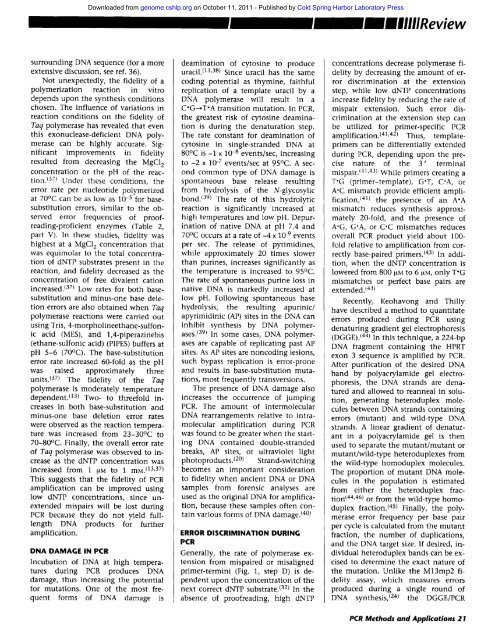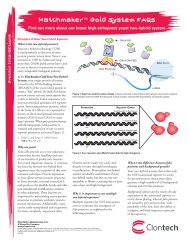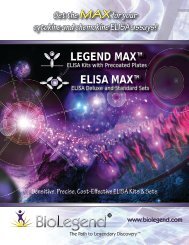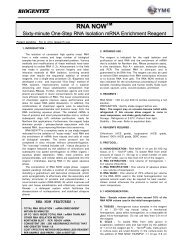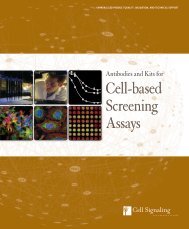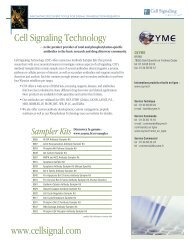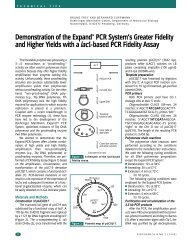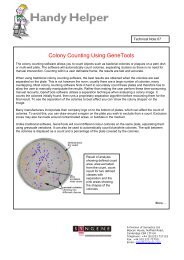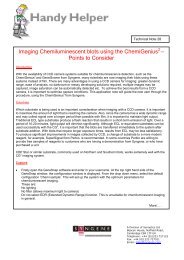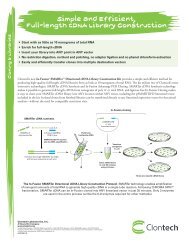DNA polymerase fidelity and the polymerase chain reaction. - Ozyme
DNA polymerase fidelity and the polymerase chain reaction. - Ozyme
DNA polymerase fidelity and the polymerase chain reaction. - Ozyme
You also want an ePaper? Increase the reach of your titles
YUMPU automatically turns print PDFs into web optimized ePapers that Google loves.
Downloaded from genome.cshlp.org on October 11, 2011 - Published by Cold Spring Harbor Laboratory Press<br />
surrounding <strong>DNA</strong> sequence (for a more<br />
extensive discussion, see ref. 36).<br />
Not unexpectedly, <strong>the</strong> <strong>fidelity</strong> of a<br />
polymerization <strong>reaction</strong> in vitro<br />
depends upon <strong>the</strong> syn<strong>the</strong>sis conditions<br />
chosen. The influence of variations in<br />
<strong>reaction</strong> conditions on <strong>the</strong> <strong>fidelity</strong> of<br />
Taq <strong>polymerase</strong> has revealed that even<br />
this exonuclease-deficient <strong>DNA</strong> <strong>polymerase</strong><br />
can be highly accurate. Significant<br />
improvements in <strong>fidelity</strong><br />
resulted from decreasing <strong>the</strong> MgC12<br />
concentration or <strong>the</strong> pH of <strong>the</strong> <strong>reaction</strong>.<br />
(37) Under <strong>the</strong>se conditions, <strong>the</strong><br />
error rate per nucleotide polymerized<br />
at 70~ can be as low as 10 -s for basesubstitution<br />
errors, similar to <strong>the</strong> observed<br />
error frequencies of proofreading-proficient<br />
enzymes (Table 2,<br />
part V). In <strong>the</strong>se studies, <strong>fidelity</strong> was<br />
highest at a MgCI 2 concentration that<br />
was equimolar to <strong>the</strong> total concentration<br />
of dNTP substrates present in <strong>the</strong><br />
<strong>reaction</strong>, <strong>and</strong> <strong>fidelity</strong> decreased as <strong>the</strong><br />
concentration of free divalent cation<br />
increased. (37) Low rates for both basesubstitution<br />
<strong>and</strong> minus-one base deletion<br />
errors are also obtained when Taq<br />
<strong>polymerase</strong> <strong>reaction</strong>s were carried out<br />
using Tris, 4-morpholineethane-sulfonic<br />
acid (MES), <strong>and</strong> 1,4-piperazinebis<br />
(ethane-sulfonic acid) (PIPES) buffers at<br />
pH 5-6 (70~ The base-substitution<br />
error rate increased 60-fold as <strong>the</strong> pH<br />
was raised approximately three<br />
units) 37) The <strong>fidelity</strong> of <strong>the</strong> Taq<br />
<strong>polymerase</strong> is moderately temperature<br />
dependent. (13) Two- to threefold increases<br />
in both base-substitution <strong>and</strong><br />
minus-one base deletion error rates<br />
were observed as <strong>the</strong> <strong>reaction</strong> temperature<br />
was increased from 23-30~ to<br />
70-80~ Finally, <strong>the</strong> overall error rate<br />
of Taq <strong>polymerase</strong> was observed to increase<br />
as <strong>the</strong> dNTP concentration was<br />
increased from 1 gM tO 1 mM. (13,37)<br />
This suggests that <strong>the</strong> <strong>fidelity</strong> of PCR<br />
amplification can be improved using<br />
low dNTP concentrations, since unextended<br />
mispairs will be lost during<br />
PCR because <strong>the</strong>y do not yield fulllength<br />
<strong>DNA</strong> products for fur<strong>the</strong>r<br />
amplification.<br />
<strong>DNA</strong> DAMAGE IN PCR<br />
Incubation of <strong>DNA</strong> at high temperatures<br />
during PCR produces <strong>DNA</strong><br />
damage, thus increasing <strong>the</strong> potential<br />
for mutations. One of <strong>the</strong> most frequent<br />
forms of <strong>DNA</strong> damage is<br />
deamination of cytosine to produce<br />
uracil. (13,38) Since uracil has <strong>the</strong> same<br />
coding potential as thymine, faithful<br />
replication of a template uracil by a<br />
<strong>DNA</strong> <strong>polymerase</strong> will result in a<br />
C'G~T~ transition mutation. In PCR,<br />
<strong>the</strong> greatest risk of cytosine deamination<br />
is during <strong>the</strong> denaturation step.<br />
The rate constant for deamination of<br />
cytosine in single-str<strong>and</strong>ed <strong>DNA</strong> at<br />
80~ is -1 x 10 -8 events/sec, increasing<br />
to -2 x 10 .7 events/sec at 95~ A second<br />
common type of <strong>DNA</strong> damage is<br />
spontaneous base release resulting<br />
from hydrolysis of <strong>the</strong> N-glycosylic<br />
bond. (39) The rate of this hydrolytic<br />
<strong>reaction</strong> is significantly increased at<br />
high temperatures <strong>and</strong> low pH. Depurination<br />
of native <strong>DNA</strong> at pH 7.4 <strong>and</strong><br />
70~ occurs at a rate of -4 x 10 -9 events<br />
per sec. The release of pyrimidines,<br />
while approximately 20 times slower<br />
than purines, increases significantly as<br />
<strong>the</strong> temperature is increased to 95~<br />
The rate of spontaneous purine loss in<br />
native <strong>DNA</strong> is markedly increased at<br />
low pH. Following spontaneous base<br />
hydrolysis, <strong>the</strong> resulting apurinic/<br />
apyrimidinic (AP) sites in <strong>the</strong> <strong>DNA</strong> can<br />
inhibit syn<strong>the</strong>sis by <strong>DNA</strong> <strong>polymerase</strong>s.<br />
(39) In some cases, <strong>DNA</strong> <strong>polymerase</strong>s<br />
are capable of replicating past AP<br />
sites. As AP sites are noncoding lesions,<br />
such bypass replication is error-prone<br />
<strong>and</strong> results in base-substitution mutations,<br />
most frequently transversions.<br />
The presence of <strong>DNA</strong> damage also<br />
increases <strong>the</strong> occurrence of jumping<br />
PCR. The amount of intermolecular<br />
<strong>DNA</strong> rearrangements relative to intramolecular<br />
amplification during PCR<br />
was found to be greater when <strong>the</strong> starting<br />
<strong>DNA</strong> contained double-str<strong>and</strong>ed<br />
breaks, AP sites, or ultraviolet light<br />
photoproducts. (2~ Str<strong>and</strong>-switching<br />
becomes an important consideration<br />
to <strong>fidelity</strong> when ancient <strong>DNA</strong> or <strong>DNA</strong><br />
samples from forensic analyses are<br />
used as <strong>the</strong> original <strong>DNA</strong> for amplification,<br />
because <strong>the</strong>se samples often contain<br />
various forms of <strong>DNA</strong> damage. (4~<br />
ERROR DISCRIMINATION DURING<br />
PCR<br />
Generally, <strong>the</strong> rate of <strong>polymerase</strong> extension<br />
from mispaired or misaligned<br />
primer-termini (Fig. 1, step D) is dependent<br />
upon <strong>the</strong> concentration of <strong>the</strong><br />
next correct dNTP substrate. (32) In <strong>the</strong><br />
absence of proofreading, high dNTP<br />
concentrations decrease <strong>polymerase</strong> <strong>fidelity</strong><br />
by decreasing <strong>the</strong> amount of error<br />
discrimination at <strong>the</strong> extension<br />
step, while low dNTP concentrations<br />
increase <strong>fidelity</strong> by reducing <strong>the</strong> rate of<br />
mispair extension. Such error discrimination<br />
at <strong>the</strong> extension step can<br />
be utilized for primer-specific PCR<br />
amplification.(41,42) Thus, templateprimers<br />
can be differentially extended<br />
during PCR, depending upon <strong>the</strong> precise<br />
nature of <strong>the</strong> 3' terminal<br />
mispair. (41,43) While primers creating a<br />
T'G (primer-template), G'T, C'A, or<br />
A'C mismatch provide efficient amplification,<br />
(41) <strong>the</strong> presence of an A'A<br />
mismatch reduces syn<strong>the</strong>sis approximately<br />
20-fold, <strong>and</strong> <strong>the</strong> presence of<br />
A'G, G'A, or C'C mismatches reduces<br />
overall PCR product yield about 100-<br />
fold relative to amplification from correctly<br />
base-paired primers. (43) In addition,<br />
when <strong>the</strong> dNTP concentration is<br />
lowered from 800 i.tM to 6 BM, only T~<br />
mismatches or perfect base pairs are<br />
extended.(43)<br />
Recently, Keohavong <strong>and</strong> Thilly<br />
have described a method to quantitate<br />
errors produced during PCR using<br />
denaturing gradient gel electrophoresis<br />
(DGGE). (44) In this technique, a 224-bp<br />
<strong>DNA</strong> fragment containing <strong>the</strong> HPRT<br />
exon 3 sequence is amplified by PCR.<br />
After purification of <strong>the</strong> desired <strong>DNA</strong><br />
b<strong>and</strong> by polyacrylamide gel electrophoresis,<br />
<strong>the</strong> <strong>DNA</strong> str<strong>and</strong>s are denatured<br />
<strong>and</strong> allowed to reanneal in solution,<br />
generating heteroduplex molecules<br />
between <strong>DNA</strong> str<strong>and</strong>s containing<br />
errors (mutant) <strong>and</strong> wild-type <strong>DNA</strong><br />
str<strong>and</strong>s. A linear gradient of denaturant<br />
in a polyacrylamide gel is <strong>the</strong>n<br />
used to separate <strong>the</strong> mutant/mutant or<br />
mutant/wild-type heteroduplexes from<br />
<strong>the</strong> wild-type homoduplex molecules.<br />
The proportion of mutant <strong>DNA</strong> molecules<br />
in <strong>the</strong> population is estimated<br />
from ei<strong>the</strong>r <strong>the</strong> heteroduplex fraction<br />
(44'46) or from <strong>the</strong> wild-type homoduplex<br />
fraction.(4s) Finally, <strong>the</strong> <strong>polymerase</strong><br />
error frequency per base pair<br />
per cycle is calculated from <strong>the</strong> mutant<br />
fraction, <strong>the</strong> number of duplications,<br />
<strong>and</strong> <strong>the</strong> <strong>DNA</strong> target size. If desired, individual<br />
heteroduplex b<strong>and</strong>s can be excised<br />
to determine <strong>the</strong> exact nature of<br />
<strong>the</strong> mutation. Unlike <strong>the</strong> M13mp2 <strong>fidelity</strong><br />
assay, which measures errors<br />
produced during a single round of<br />
<strong>DNA</strong> syn<strong>the</strong>sisJ 24) <strong>the</strong> DGGE/PCR<br />
PCR Methods <strong>and</strong> Applications 21


